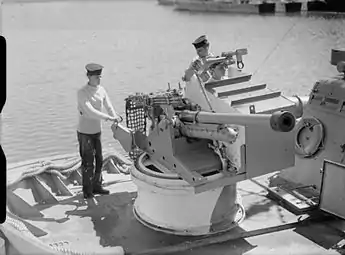Fairmile D motor torpedo boat
The Fairmile D motor torpedo boat was a type of British motor torpedo boat (MTB) and motor gunboat (MGB)[1] designed by Bill Holt and conceived by Fairmile Marine for the Royal Navy. Nicknamed "Dog Boats", they were designed to combat the known advantages of the German E-boats over previous British coastal craft designs. They were bigger than earlier MTB or motor gunboat (MGB) designs (which were typically around 70 feet) but slower, at 30 knots compared to 40 knots.
 The Fairmile D motor gun boat MGB 606 | |
| Class overview | |
|---|---|
| Name | Fairmile D motor gun boat |
| Preceded by | Fairmile C motor gun boat |
| Completed | 229 |
| General characteristics | |
| Displacement | |
| Length | 115 ft (35 m) |
| Beam | 20 ft 10 in (6.35 m) |
| Draught | 4 ft 9 in (1.45 m) to 4 ft 11 in (1.50 m) mean deep load |
| Propulsion | 4 × Packard 4M 2500 petrol engines, total 5,000 hp (3,728 kW) |
| Speed | 29 knots (54 km/h; 33 mph) at full load |
| Range |
|
| Complement | 21 |
| Armament |
|
| Notes | Specifications from Conway's All the World's Fighting Ships 1922–1946. and Motor Gunboat 658 |
History
Unlike the Fairmile B designs, the Dog Boats were only produced in component form in Britain. Some were built for the RAF's Marine Branch for use in the long range air-sea rescue for downed airmen. 229 boats were built between 1942 and 1945.
Many versions were produced or converted from existing boats; MGB, MTB, MA/SB, LRRC and post-war FPB.
Since the Fairmile D could be fitted out with a mix of armament that gave it the capabilities of both a motor gunboat and a motor torpedo boat, later-war examples were all completed with a heavy combined armament and universally classified as MTBs. By 1944, the MGB designation was largely dropped by the RN and most of the mid-war (earlier model) Type Ds which had survived were reclassified as MTBs even if they lacked torpedo armament. Mediterranean-based MGBs, however, seem to have retained their MGB pennant numbers to the end of the war.
Two captured boats were put in Kriegsmarine service.
Today the D-type is a popular choice among boat modelers.
There are no known survivors, other than two abandoned wrecks, one in Chatham, England and the other in Ellingsøy, Norway.
 6-pounder (57 mm) guns with Molins autoloader were mounted on some of the D-class MTBs.
6-pounder (57 mm) guns with Molins autoloader were mounted on some of the D-class MTBs. Back view of the same gun
Back view of the same gun
 MTB 459, 1944
MTB 459, 1944 MTB 727, 1944
MTB 727, 1944
See also
Notes
- Reynolds, Leonard C. Dog Boats at War: Royal Navy D Class MTBs and MGBs, 1939–1945. 2000. ISBN 978-0-7509-1443-7
References
- Lambert, John. Fairmile D Motor Torpedo Boat. (Anatomy of the Ship series) 1985 ISBN 978-1-84486-006-7
- Lambert, John and Ross, Al. Allied Coastal Forces of World War Two, Volume I : Fairmile designs and US Submarine Chasers. 1990. ISBN 978-0-85177-519-7
- Konstam, Angus. British Motor Torpedo Boat 1939–45. (New Vanguard). Osprey 2003. ISBN 978-1-84176-500-6
- Konstam, Angus. British Motor Gun Boat 1939-45 (New Vanguard) Osprey 2010 978-1849080774
- Chesneau, Roger (editor).Conway's All the World's Fighting Ships 1922–1946. London, UK: Comway Maritime Press, 1980. ISBN 0-85177-146-7
- Reynolds, Leonard C. Motor Gunboat 658: The Small Boat War in the Mediterranean 1955/2002. ISBN 0-304-36183-6